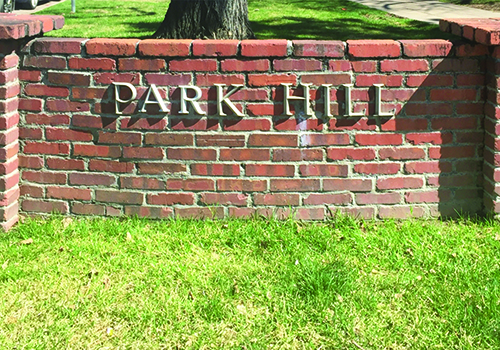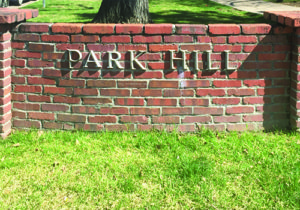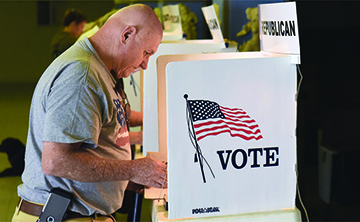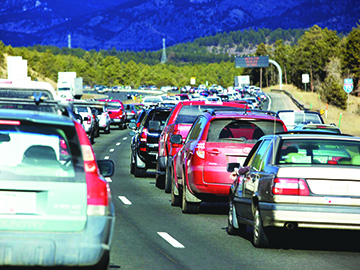
by Mark Smiley | May 26, 2021 | Main Articles
Homeless Camp Is Just Blocks From Park Hill Home Of Hickenlooper Who Said He Would End Homelessness; Advocates Demand The Homeless ‘Liberate’ Hick House For Use By All
by Glen Richardson
When the pandemic hit Denver last year and layoff climbed, the lack of affordable housing resulted in homeless encampments growing exponentially. As encampments multiplied, the problem began spreading to surrounding neighborhoods.
That’s where this story begins. More precisely in Denver’s Park Hill, a community that rivals Riverside Dr. in New York, the Auteuil and Passy in Paris, and Mayfair in London. The neighborhood was designed to showcase Mayor Speer’s Beautiful City Program. U.S. Senator and former Colorado Governor John Hickenlooper has a $2.5 million home here. With homes selling in five days or less, 52 homes and two condos were for sale last month, listed from $285,000 to $1,975,00.
This month an encampment with 45 shelters serving 50 people opens in a parking lot behind the church at 5209 Montview Blvd. The arrangement is scheduled to remain at least until Dec. 31. Homeless are being moved here from Capitol Hill. Suddenly, the plight of those living on the streets becomes intimately linked to the well-being of everybody else living in the neighborhood.

Hick’s Hood: Park Hill neighborhood was designed by landscape architect Fredrick Law Olmsted. Many of the neighborhoods first residences were designed by Fisher & Fisher.
Serenity Of Home
Hickenlooper, who as a U.S. Senator, spends much of his time in Washington, D.C. — the nation’s No. 1 homeless city — likely looks forward to returning to his Montview Blvd. home surrounded by an abundance of mature trees, lushly landscaped medians and generous setback. But with a homeless encampment moving within a block of Hick’s home he may soon be scanning Yelp reviews for a highly rated real estate agent.
The paradox is that Hickenlooper declared he would “end homelessness” with his Denver’s Road Home initiative in 2005. It was a miserable failure. An audit released in April 2019, by Denver Auditor Timothy M. O’Brien, CPA, concluded: “A lack of a cohesive overall strategy along with unclear authority and understaffing hindered the city’s ability to comprehensively address homelessness or measure the effectiveness of its efforts.”
The audit revealed that in 2018, the Metro Homeless Initiative identified 3,445 individuals experiencing homelessness. Around $37 million was budgeted for homeless services in 2018 and in 2019. Denver increased that to more than $51 million. In a warning seemingly still being ignored, O’Brien said, “Millions of dollars won’t help solve the problem if we aren’t tracking data and aligning our policies from organization to organization to support the use of the city’s resources.”
Camp Hick
Some homeless advocates are demanding that Hickenlooper make available his home to the denizens of the new Park Hill Safe homeless encampment. They point out the homeless will need places to go during the day and do not want to be stuck in a hot asphalt parking lot in the summer and what better than the green expanses of the Hickenlooper home. In the winter he could open up his home while he is off in Washington, D.C. “He promised to end homelessness in 10 years but failed miserably,” said David Johnson. “Opening up his home to the new Park Hill homeless residents is the least he could do to start making amends and if he won’t then the homeless should just go down there and take it over.”
Upset Neighbors Go To Court
Whether Hickenlooper is upset or not, other Park Hill residents are distraught and troubled. In the most significant attempt ever to block the establishment of the camping site, a group of Park Hill residents sued the nonprofit Colorado Village Collaborative, Park Hill United Methodist Church and the City of Denver to stop the neighborhood camping site. Residents in neighborhoods such as Globeville and Elyria-Swansea have vocally argued against camping sites, but this is the first lawsuit.
A temporary restraining order and preliminary injunction was filed by attorneys Heather Anderson Thomas and Douglas W. Baier on behalf of five plaintiffs on May 6. The site has not met the requirements set out by the city, according to the complaint filed by five Park Hill residents.
The lawsuit stated the proposed site “poses a real danger to minors and school-aged children, does not address the impact it will have on the neighborhood, and displaces people from an area with available resources to an area not equipped to handle the purposes of the camping site.”
Just 13 days after the injunction was filed, Denver District Court Judge A. Bruce Jones dismissed the lawsuit asserting that the plaintiffs had not exhausted all of their administrative remedies to the Denver Board of Adjustment for Zoning Appeals. The plaintiffs indicate they are now filing such an appeal but note that the camp will be in before the appeal is even heard.
Colorado Village Collaborative and Park Hill United Methodist Church celebrated the ruling with a joint statement declar
ing “we are grateful to the many Park Hill neighbors who have already opened their arms to receive their newest neighbors by expressing their support, opening their wallets, swapping recipes that will feed a crowd, and committing to volunteer on an ongoing basis.”
Not All Residents Hostile
Some residents in Park Hill believe that they must demonstrate their progressive values. They indicated that they would be willing to bake cookies and brownies for the new Park Hill homeless. Terrell wrote on Westword’s Facebook: “I am mortified today to say I am from Park Hill. That said, there are literally hundreds of us actively planning how we will welcome these brothers and sisters, and truly demonstrate what a privileged neighborhood can be capable of, beyond hate.”
Preschool Steps Away
 The homeless encampment will be just a few feet from the Children’s Center at Park Hill United Methodist Church. The pre-school offers half-day, full-day and after school programs. There are three public schools in the neighborhood, Park Hill Elementary School, The Goddard School of Denver and Odyssey School of Denver.
The homeless encampment will be just a few feet from the Children’s Center at Park Hill United Methodist Church. The pre-school offers half-day, full-day and after school programs. There are three public schools in the neighborhood, Park Hill Elementary School, The Goddard School of Denver and Odyssey School of Denver.
Residents in the Capitol Hill neighborhood where the encampment is being relocated from claimed that Morey Middle School near the site became a safety issue. “Tents lined the public-right-of-way between the street and the sidewalk outside of the school, and there were baskets and boxes filled with belongings.
Lara Lee Hullinghorst, a lobbyist and daughter of former Colorado Speaker of the House Dickey Lee Hullinghorst, said she was scared to walk out of her apartment without her husband or a friend after a man grabbed her arm and threatened to rape and kill her. She wasn’t certain, but believed the man lived in the camp across the street.
Church Champions Justice
Completing final preparations to share their space with unhoused homeless, Park Hill United Methodist Church — also home to Temple Micah — has a long hi story of supporting racial and social justice. They’ve offered sanctuary to immigrants and refugees.
story of supporting racial and social justice. They’ve offered sanctuary to immigrants and refugees.
Moreover, they have been hosting women experiencing home
lessness for years through the Women’

Modern Skid Row: Denver’s homeless population is now at nearly the 10,000 mark, resulting in city adding more and more camping sites such as this, left. This type of encampment is coming this summer to Park Hill United Methodist Church, right.
s Homelessness Initiative.
Rules for the camp ask their new homeless residents to, “Be a good neighbor and treat private property, schools, children and families with respect.” Guidelines include no violence, weapons, drugs, or alcohol. Theft, fires, disruptive behavior, and trading and selling substances are forbidden. Whether any or all of these admonitions will be observed is unknown.
Today’s Hoovervilles
For most of us the magic thing about home is that it feels good to leave, and it feels even better to come back. Unfortunately, today in Denver many citizens can’t afford to come back.
Denver currently ranks 42nd in the nation when it comes to providing affordable housing for its low-income residents. As a result, every night, thousands of our fellow Denverites are forced to sleep on the streets without the warmth, safety, and security that so many of us take for granted.
As if harkening back to the Hoovervilles of the Great Depression, these settlements have become fixtures known as encampments.
Today Denver’s homeless population is 9,619, or 16.7 homeless people per 10,000 residents, according to a new study by website Porch.com. The website says the share of the homeless population in Colorado is now the 10th highest rate among the 50 states.

by Glendale Sports Center | May 26, 2021 | Feature Story Bottom Left
 by Elizabeth Bravman, Nutritionist, Healthy Heart Ambassador, Cycling Instructor, YMCA of Metro Denver
by Elizabeth Bravman, Nutritionist, Healthy Heart Ambassador, Cycling Instructor, YMCA of Metro Denver
We all know that WHAT we eat is very important for our overall health. But did you know that thinking about WHY and HOW you eat can bring your wellness to a whole new level? Practicing Mindful eating can help us do just that.
The opposite of “mindful” eating is “mindless” eating. What is that?
- Have you ever eaten a quick breakfast in the car?
- Eaten lunch while doing work at your desk or dinner in front of the TV?
- Snacked right from a large bag or container while you scrolled through your phone?
If you answered yes to any of these questions, then you have mindlessly eaten. You are not alone. Most Americans practice some sort of disconnected eating every day. Food is part of our culture, and we have a distorted view of portion sizes. Plus, we love to multitask which is the perfect recipe for mindless eating. These habits can lead to overeating, weight gain and serious health risks.
Mindful eating can help us avoid the pitfalls of mindless eating and bring us back in touch with how and why we eat.
Stay connected by pausing and asking these three why and how questions:
- Am I truly hungry? Seems like an easy question but since we live in a toxic food environmen
 t that is constantly sending us external messages about eating, it can be difficult to tap into those internal cues of hunger. Sometimes it’s a clock telling us to eat, we see or smell food or we are in a social setting, and we eat regardless of being hungry.
t that is constantly sending us external messages about eating, it can be difficult to tap into those internal cues of hunger. Sometimes it’s a clock telling us to eat, we see or smell food or we are in a social setting, and we eat regardless of being hungry.
TIPS: Put sticky notes near your fridge, pantry, plates/bowls or silverware with this question written on it. Set up an alert in your phone that asks you this question. Often hunger can be confused with thirst, have a large glass of water while trying to decide!
- Am I satisfied? Satisfied — not full or stuffed. It takes about 20 minutes for hormones in your body to signal your brain that you are full. It’s best to stop eating when you first start to feel satisfied.
TIPS: Check in with yourself about halfway through your meal to see how you may be feeling on the satisfied scale. Take your time! Try placing your silverware down in between bites, use your non-dominant hand or chopsticks to eat to help slow you down. Set a timer for 20 minutes. If you finish before then and you think you might still be hungry, get up from the table, do dishes or take a walk, before checking in with yourself to see if you still might be hungry. If the answer is yes, then honor your hunger and eat more!
- Am I eating because I am sad, bored or stressed? Often, we eat because we are feeling something else and not hunger. Addressing these feelings directly will help avoid emotional eating.
TIPS: If you notice you want to eat because you have one of these occasional emotions, a swap can help you process the emotion. If you want to eat because you are bored some great swaps are going for a walk, listening to a podcast, calling/texting a friend or cleaning. A swap for stressed emotions may be exercise or venting to a friend. Sad or lonely? Call/text a close friend, journal, or try a warm bath or a funny TV show. It is important to note that if these emotions are intense and/or frequent, seek support from a health professional.
- Am I eating with distractions? With distractions we miss our internal cues of satiety and may overeat. Remove technology, work, reading materials, or other distractions while eating. Be present and focus on enjoying your food.
TIPS: Sticky notes or alerts on your phone to put away all distractions can help. Saying a blessing over your meal or acknowledging where your food has come from and how many hands were involved in bringing it to your table can also bring your focus to eating.
- Am I setting myself up for success with appropriate portion sizes? Portion sizes should not matter if you are paying attention to your internal cues but… we’re human and studies show that large portion sizes push people to overeat!
TIPS: Learn average portion sizes for you. Don’t eat directly out of containers or bags, portion into smaller plates and bowls. Using smaller plates and bowls will make you feel like you have more. Don’t forget to check in with yourself — some days the average portion size might be too much or not enough depending on what is going on in your life!
- Am I enjoying my food? Food should taste good, and eating should be enjoyable!
TIPS: Sit down and simply observe your food — its textures, colors, and smells. Chew slowly, noticing flavors and sensations. If you are in a group, it’s fun to experience this together, making observations and comparisons. Journal about your food. With children, it’s great to play games where everyone closes their eyes and describes their first bite in detail.
The act of pausing and bringing your attention to why and how you are eating may open your eyes to certain aspects of your eating that can be improved. Be curious in a non-judgmental way. Notice your answers and consider the factors influencing you.
Be gentle on yourself as you start to practice thinking about why and how you eat. Try to incorporate just one question into your day and make sure it’s one that feels doable to you right now. Try something like: “I will not use any technology or have any distractions during lunch on Tuesdays and Thursdays this week” or “I will not eat chips right from the bag on Friday nights.”
This is a lifelong practice with the goal of simply becoming more mindful at eating. The more you practice, the easier it gets.
If you need any nutritional support, the YMCA of Metro Denver’s nutrition team can be contacted through denverymca.org.

by Valley Gadfly | May 26, 2021 | Valley Gadfly
Happy June everybody! Despite the rain, May seemed to fly right by. No complaints, June is our favorite month of the year! Why? Well, June 20 is officially the start of summer, and we can’t wait to soak up the sunshine after this year’s abnormally snowy, rainy-drizzly and cold weather versus the predictions of a hot and dry year.
Summer Solstice begins in Denver on Sunday, June 20, at 9:32 p.m. In terms of daylight, the day will be five hours, 38 minutes longer than the December Solstice.
To ensure nothing is so rare as days in June, here are our choices for shopping, dining and entertainment so those getaways and backyard barbecues reign supreme:
3 Keep your youngsters — kindergarten through 8th grade — active this month by signing them up for rugby’s Spring Try League at Infinity Park. Practice is Tues. & Thurs., games on Sat. Information: 303-639-4713.
3 Catch the legendary band Sons of Genesis with Chris Swaney doing vocals at Dazzle@Baur’s June 4, 6 p.m. Information: 303-839-5100.
3 Walk, run, bike, or swim at Morgan Adams Foundation’s cancer fundraiser Petri Dish at Sloan’s Lake Park June 4-6. Information: 303-758-2130.
3 Join neighbors and others at Junk In The Trunk, a garage sale with a twist, at the Owl Saloon June 5, 11 a.m.-4 p.m. Information: theowlsaloon.com.
3 For Father’s Day treat papa and the clan to rotisserie meats, fish and vegetables at The Rotary on S. Holly next to Park Burger. Order beer, wine and craft cocktails for the fab food. Information: 303-537-5327.
3 Get back in the game with fitness classes and league sports at the Glendale Sports Center. No joining fees or contracts. Choose from basketball, outdoor soccer, table tennis and pickleball. Information: 303-639-4711.
3 Enjoy a picnic, yoga, and violin tunes at Vinyasa, Violins & Vino June 17 and 24 at Denver Botanic Gardens, 6:30 p.m. Information: 720-865-3500;
3 Savor soothing soul and funk rhythms by Earth, Wind & Fire and guitarist Santana at the Ball Arena June 30, 7 p.m. Information: 888-684-3582.
3 Live music is finally returning to Four Mile Historic Park with the announcement Swallow Hill is bringing back the eagerly awaited Shady Grove Picnic Series. Concerts are on Thursdays, June 3-Aug. 26, 6:30 p.m. Hal Aqua & The Lost Tribe kicks off the series followed by Dakota Blonde on June 10. Cary Morin & Ghost Dog entertain on June 17 followed on June 24 by Extra Gold. Information: 303-777-1003.
June and the beginning of summer draw special attention to the simple pleasures of life on a day-to-day basis. Possibly that is why the first week of June is officially National Fishing Week and the fourth week of June is National Camping Week.
British horticulturist Gertrude Jekyll said this of June: “The fulfillment of the promise of earlier months, yet no sign to remind us this fresh beauty will ever fade.”
A gardening month, June’s misty mornings burn away, followed by breezy afternoons and chilly nights. June isn’t only loved by us; it also pops up in song lyrics. Richard Rodgers said it best in June Is Bustin’ Out All Over: “You can feel it in your heart, you can see it in the trees, smell it in the breeze. Because it’s June, June, June.”
— Glen Richardson
The Valley Gadfly can be reached at newspaper@glendalecherrycreek.com.

by Charles Bonniwell | May 26, 2021 | Editorials
 Mark Twain famously said: “If voting made any difference, they wouldn’t let us do it.” His remarks certainly apply to Colorado today as the new Colorado Transportation Bill SB21-260 demonstrates. Colorado voters have repeatedly declared, since 1992 with the adoption of the Taxpayer Bill of Rights (“TABOR”), that they wanted to be able to vote on approving new tax increases. Similarly, Colorado taxpayers have repeatedly said that they do not want new taxes for roads. In fall of 2019, Proposition CC failed which would have allowed the state to keep the refunds that would have otherwise gone back to taxpayers under TABOR for roads. In the fall of 2020, voters turned down two Propositions, 109 and 110, which would have raised taxes for roads. In addition the voters approved Proposition 117, a measure requiring voter approval on fee hikes that generate more than $100 million in revenue over five years.
Mark Twain famously said: “If voting made any difference, they wouldn’t let us do it.” His remarks certainly apply to Colorado today as the new Colorado Transportation Bill SB21-260 demonstrates. Colorado voters have repeatedly declared, since 1992 with the adoption of the Taxpayer Bill of Rights (“TABOR”), that they wanted to be able to vote on approving new tax increases. Similarly, Colorado taxpayers have repeatedly said that they do not want new taxes for roads. In fall of 2019, Proposition CC failed which would have allowed the state to keep the refunds that would have otherwise gone back to taxpayers under TABOR for roads. In the fall of 2020, voters turned down two Propositions, 109 and 110, which would have raised taxes for roads. In addition the voters approved Proposition 117, a measure requiring voter approval on fee hikes that generate more than $100 million in revenue over five years.
None of it mattered in the least. Under SB21-260 the state legislature imposes an estimated $4 billion in new fees over 10 years for so-called transportation needs. That is an estimated $1,750 per household. How did they do it? Well, they divided the fees into four different enterprises, none of them individually exceeds the limit. One other fee, however, easily exceeded the limit, but they put that fee into a Highway Users Tax Fund, and since it is not an enterprise, it does not need voter approval.
One would think the Colorado courts would strike down such shenanigans, but we are assured by the conservative Independence Institute that the Colorado Supreme Court would find a way to approve the same. Given the black eye the Colorado judiciary has gotten from the discovery that the Judicial Department and Colorado’s former chief justice awarded a multimillion dollar contract to an employee to prevent her from disclosing incidents of workplace misconduct and sex discrimination, the courts might want the citizens to at least think they are not so biased that they can render impartial rulings, but apparently not.
The solution the Independence Institute gives us, is that ultimately the voters can punish those legislators who passed the legislation over the wishes of the voters. But in Colorado that has become a joke. Mail-in ballots and ballot harvesting in Denver make it impossible for anybody but a Democrat to win statewide office and assures a Democrat controlled State House and State Senate. That is why the State Legislature could care less what the voters want or do not want.
 There is at least a silver lining in all of this. Voters have indicated that they do not want new taxes or new fees used to build and repair roads and bridges, and under SB21-260 very little of the money will be used for that. It is estimated the roads and bridges will be involved in only 17% to 18% of the spending and rest used for subsidies for electric cars and multimodal transportation. So, after a flurry of spending the roads in Colorado will remain highly congested and in poor repair. Nothing will change except the lightening of the public pockets.
There is at least a silver lining in all of this. Voters have indicated that they do not want new taxes or new fees used to build and repair roads and bridges, and under SB21-260 very little of the money will be used for that. It is estimated the roads and bridges will be involved in only 17% to 18% of the spending and rest used for subsidies for electric cars and multimodal transportation. So, after a flurry of spending the roads in Colorado will remain highly congested and in poor repair. Nothing will change except the lightening of the public pockets.
You could, of course, call your duly elected state representative/senator but many of them are not even bothering these days to take such calls or read constituent mail. Why should they? In case you have not figured it out yet, you don’t live in a democratic republic in Colorado, but an interesting form of an oligarchy. You can have fun voting, relieved of any burden that your vote, as Mark Twain noted, “makes any difference.”
— Editorial Board


 The homeless encampment will be just a few feet from the Children’s Center at Park Hill United Methodist Church. The pre-school offers half-day, full-day and after school programs. There are three public schools in the neighborhood, Park Hill Elementary School, The Goddard School of Denver and Odyssey School of Denver.
The homeless encampment will be just a few feet from the Children’s Center at Park Hill United Methodist Church. The pre-school offers half-day, full-day and after school programs. There are three public schools in the neighborhood, Park Hill Elementary School, The Goddard School of Denver and Odyssey School of Denver. story of supporting racial and social justice. They’ve offered sanctuary to immigrants and refugees.
story of supporting racial and social justice. They’ve offered sanctuary to immigrants and refugees.






